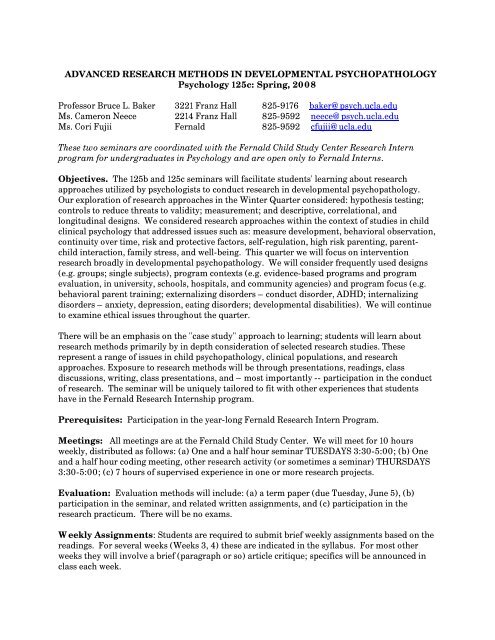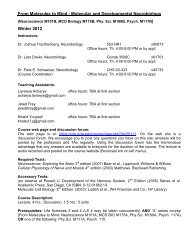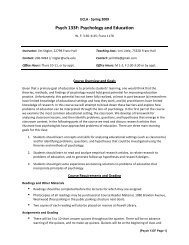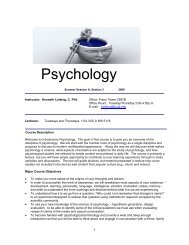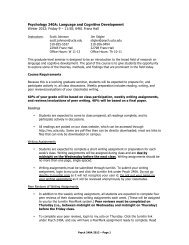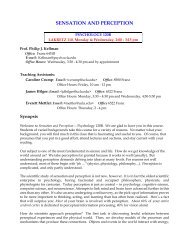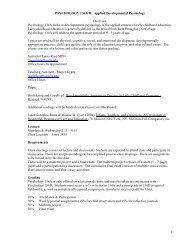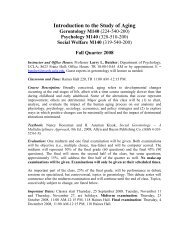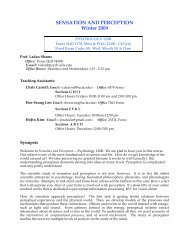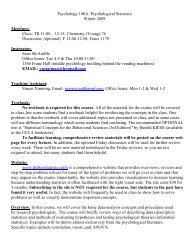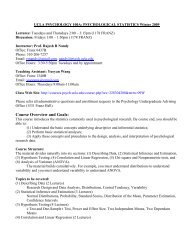advanced research methods in developmental psychopathology
advanced research methods in developmental psychopathology
advanced research methods in developmental psychopathology
You also want an ePaper? Increase the reach of your titles
YUMPU automatically turns print PDFs into web optimized ePapers that Google loves.
ADVANCED RESEARCH METHODS IN DEVELOPMENTAL PSYCHOPATHOLOGY<br />
Psychology 125c: Spr<strong>in</strong>g, 2008<br />
Professor Bruce L. Baker 3221 Franz Hall 825-9176 baker@psych.ucla.edu<br />
Ms. Cameron Neece 2214 Franz Hall 825-9592 neece@psych.ucla.edu<br />
Ms. Cori Fujii Fernald 825-9592 cfujii@ucla.edu<br />
These two sem<strong>in</strong>ars are coord<strong>in</strong>ated with the Fernald Child Study Center Research Intern<br />
program for undergraduates <strong>in</strong> Psychology and are open only to Fernald Interns.<br />
Objectives. The 125b and 125c sem<strong>in</strong>ars will facilitate students' learn<strong>in</strong>g about <strong>research</strong><br />
approaches utilized by psychologists to conduct <strong>research</strong> <strong>in</strong> <strong>developmental</strong> <strong>psychopathology</strong>.<br />
Our exploration of <strong>research</strong> approaches <strong>in</strong> the W<strong>in</strong>ter Quarter considered: hypothesis test<strong>in</strong>g;<br />
controls to reduce threats to validity; measurement; and descriptive, correlational, and<br />
longitud<strong>in</strong>al designs. We considered <strong>research</strong> approaches with<strong>in</strong> the context of studies <strong>in</strong> child<br />
cl<strong>in</strong>ical psychology that addressed issues such as: measure development, behavioral observation,<br />
cont<strong>in</strong>uity over time, risk and protective factors, self-regulation, high risk parent<strong>in</strong>g, parentchild<br />
<strong>in</strong>teraction, family stress, and well-be<strong>in</strong>g. This quarter we will focus on <strong>in</strong>tervention<br />
<strong>research</strong> broadly <strong>in</strong> <strong>developmental</strong> <strong>psychopathology</strong>. We will consider frequently used designs<br />
(e.g. groups; s<strong>in</strong>gle subjects), program contexts (e.g. evidence-based programs and program<br />
evaluation, <strong>in</strong> university, schools, hospitals, and community agencies) and program focus (e.g.<br />
behavioral parent tra<strong>in</strong><strong>in</strong>g; externaliz<strong>in</strong>g disorders – conduct disorder, ADHD; <strong>in</strong>ternaliz<strong>in</strong>g<br />
disorders – anxiety, depression, eat<strong>in</strong>g disorders; <strong>developmental</strong> disabilities). We will cont<strong>in</strong>ue<br />
to exam<strong>in</strong>e ethical issues throughout the quarter.<br />
There will be an emphasis on the "case study" approach to learn<strong>in</strong>g; students will learn about<br />
<strong>research</strong> <strong>methods</strong> primarily by <strong>in</strong> depth consideration of selected <strong>research</strong> studies. These<br />
represent a range of issues <strong>in</strong> child <strong>psychopathology</strong>, cl<strong>in</strong>ical populations, and <strong>research</strong><br />
approaches. Exposure to <strong>research</strong> <strong>methods</strong> will be through presentations, read<strong>in</strong>gs, class<br />
discussions, writ<strong>in</strong>g, class presentations, and – most importantly -- participation <strong>in</strong> the conduct<br />
of <strong>research</strong>. The sem<strong>in</strong>ar will be uniquely tailored to fit with other experiences that students<br />
have <strong>in</strong> the Fernald Research Internship program.<br />
Prerequisites: Participation <strong>in</strong> the year-long Fernald Research Intern Program.<br />
Meet<strong>in</strong>gs: All meet<strong>in</strong>gs are at the Fernald Child Study Center. We will meet for 10 hours<br />
weekly, distributed as follows: (a) One and a half hour sem<strong>in</strong>ar TUESDAYS 3:30-5:00; (b) One<br />
and a half hour cod<strong>in</strong>g meet<strong>in</strong>g, other <strong>research</strong> activity (or sometimes a sem<strong>in</strong>ar) THURSDAYS<br />
3:30-5:00; (c) 7 hours of supervised experience <strong>in</strong> one or more <strong>research</strong> projects.<br />
Evaluation: Evaluation <strong>methods</strong> will <strong>in</strong>clude: (a) a term paper (due Tuesday, June 5), (b)<br />
participation <strong>in</strong> the sem<strong>in</strong>ar, and related written assignments, and (c) participation <strong>in</strong> the<br />
<strong>research</strong> practicum. There will be no exams.<br />
Weekly Assignments: Students are required to submit brief weekly assignments based on the<br />
read<strong>in</strong>gs. For several weeks (Weeks 3, 4) these are <strong>in</strong>dicated <strong>in</strong> the syllabus. For most other<br />
weeks they will <strong>in</strong>volve a brief (paragraph or so) article critique; specifics will be announced <strong>in</strong><br />
class each week.
2<br />
SCHEDULE OF CLASSES<br />
SPRING QUARTER: INTERVENTION RESEARCH<br />
1. April 1 CFS Research Presentations<br />
2. *April 10 Intervention Research: Issues and Group Designs; SPSS Analyses #5<br />
3. April 15 Intervention Research: S<strong>in</strong>gle Subject Designs<br />
4. April 22 Parent Tra<strong>in</strong><strong>in</strong>g Studies<br />
5. *May 1 Evidence Based Treatments & The MTA Study<br />
6. May 6 Evidence Based Treatments & Autism Spectrum Disorders<br />
7. May 13 Program Evaluation <strong>in</strong> Community-Based Interventions<br />
8. May 20 Research critique: Child/Adolescent Intervention studies<br />
9. May 27 Child/Adolescent Intervention studies (con.); Student <strong>research</strong> reports<br />
10. June 3 Student <strong>research</strong> reports<br />
* Thursday classes<br />
Background References (Optional):<br />
Baker, B. L., Blacher, J., Kopp, C. B. & Kraemer, B. (1997). Parent<strong>in</strong>g children with mental<br />
retardation. International Review of Research <strong>in</strong> Mental Retardation, 20, 1-45. This<br />
review paper provides a good overview of issues <strong>in</strong> parent<strong>in</strong>g and mental retardation –<br />
useful framework for understand<strong>in</strong>g the implications of CFS studies<br />
Graziano, A. M., & Raul<strong>in</strong>, M. L. (2000). Research <strong>methods</strong>: A process of <strong>in</strong>quiry. Boston:<br />
Allyn and Bacon. This book presents material that overlaps with what you covered <strong>in</strong> Psych<br />
100B. It is <strong>in</strong>cluded as a reference, for you to review if you want to.<br />
Kazd<strong>in</strong>,, A. (1999). Research <strong>in</strong> contemporary cl<strong>in</strong>ical psychology: Design and implementation.<br />
In T. G. Plante, Ed., Contemporary cl<strong>in</strong>ical psychology, Chapter 6 (pp. 97-124). This<br />
chapter is a no-frills presentation of basic <strong>methods</strong> and issues <strong>in</strong> <strong>research</strong>. It too overlaps<br />
with what you have covered <strong>in</strong> Psych 100B, but will be a good review.<br />
Kazd<strong>in</strong>, A. E., & Weisz, J. R. (2003). Evidence-based psychotherapies for children and<br />
adolescents. New York: The Guilford Press.
3<br />
SPRING QUARTER EXPANDED SCHEDULE OF CLASSES AND READINGS<br />
Read<strong>in</strong>gs designated with (*) are required. Others are optional. Copies of all read<strong>in</strong>gs<br />
(required and optional) are available <strong>in</strong> the CFS office. Please try to read the papers listed under<br />
each topic before class that week. Read<strong>in</strong>gs are listed <strong>in</strong> the best order to read them.<br />
Week 1. CFS RESEARCH PRESENTATIONS<br />
*Fenn<strong>in</strong>g, R. M., Baker, J. K., Baker, B. L., & Crnic, K. A. (2007). Parent<strong>in</strong>g children with<br />
borderl<strong>in</strong>e <strong>in</strong>tellectual function<strong>in</strong>g: A unique risk population. American Journal on Mental<br />
Retardation, 112, 107-121. Pay particular attention to the codes for parent behavior <strong>in</strong> the<br />
naturalistic sett<strong>in</strong>g.<br />
Eisenhower, A., Baker, B. L., & Blacher, J. (2005). Preschool children with <strong>in</strong>tellectual<br />
disability: Syndrome specificity, behaviour problems, and maternal well-be<strong>in</strong>g. Journal of<br />
Intellectual Disability Research,49, 657-671.<br />
Baker, B. L., McIntyre, L. L., Blacher, J., Crnic, K., Edelbrock, C., & Low, C. (2003). Preschool<br />
children with and without <strong>developmental</strong> delay: Behavior problems and parent<strong>in</strong>g stress<br />
over time. Journal of Intellectual Disability Research. Required W<strong>in</strong>ter quarter; read it<br />
now if you didn’t read it then.<br />
Week 2. INTERVENTION RESEARCH: ISSUES and GROUP DESIGNS.<br />
SPSS ANALYSIS EXERCISE #5<br />
*Kazd<strong>in</strong>, A. E., & Weisz, J. R. (2003). Introduction: Context and background of evidence-based<br />
psychotherapies for children and adolescents. In Kazd<strong>in</strong> & Weisz, Ch. 1 pp 3-20.<br />
*Weisz, J. R., Donenberg, G. R., Weiss, B., & Han, S. S. (1995). Bridg<strong>in</strong>g the gap between<br />
laboratory and cl<strong>in</strong>ic <strong>in</strong> child and adolescent psychotherapy. Journal of Consult<strong>in</strong>g and<br />
Cl<strong>in</strong>ical Psychology, 63, 688-701. Presents the major problem of differential effectiveness<br />
<strong>in</strong> the laboratory and the real-world.<br />
Hoagwood, K. (2003). Ethical issues <strong>in</strong> child and adolescent psychosocial treatment <strong>research</strong>.<br />
In A.E. Kazd<strong>in</strong> and J. R. Weisz (Eds.). Evidence-based psychotherapies for children and<br />
adolescents, Ch. 4. New York: Guilford.<br />
Week 3. INTERVENTION RESEARCH: SINGLE SUBJECT DESIGNS<br />
We will cont<strong>in</strong>ue our discussion of group designs and then consider s<strong>in</strong>gle subject designs. We<br />
will consider several approaches to s<strong>in</strong>gle-subject <strong>research</strong>, and then focus on student<br />
presentation of three s<strong>in</strong>gle-subject experiments. The Kazd<strong>in</strong> chapter will be good background.<br />
Kazd<strong>in</strong>, A. E. (1982). S<strong>in</strong>gle-case experimental designs. In Kendall, P. C. & Butcher, J. N.<br />
Handbook of <strong>research</strong> <strong>methods</strong> <strong>in</strong> cl<strong>in</strong>ical psychology, Ch. 14. New York: Wiley. Pay<br />
particular attention to pp. 461-467. (optional)
*Read one of the follow<strong>in</strong>g s<strong>in</strong>gle case articles (as assigned <strong>in</strong> class) and be prepared to report<br />
on it <strong>in</strong> class. Copies will be distributed <strong>in</strong> the first class.<br />
Ayllon, T., Layman, D., & Kandel, H. J. (1975). A behavioral-educational alternative to drug<br />
control of hyperactive children. Journal of Applied Behavior Analysis, 8, 137-146. (A<br />
classic study)<br />
Garf<strong>in</strong>kle, A. N., & Schwartz, I. S. (2002). Peer imitation: Increas<strong>in</strong>g social <strong>in</strong>teractions <strong>in</strong><br />
children with Autism and other <strong>developmental</strong> disabilities <strong>in</strong> <strong>in</strong>clusive preschool<br />
classrooms. Topics <strong>in</strong> Early Childhood Special Education, 22, 26-38.<br />
Ronen, T., (1991). Intervention package for treat<strong>in</strong>g sleep disorders <strong>in</strong> a four-year-old girl.<br />
Journal of Behavior Therapy and Experimental Psychiatry, 22, 141-148.<br />
4<br />
Week 4. PARENT TRAINING STUDIES<br />
We will discuss the Cunn<strong>in</strong>gham, Bremner, & Boyle study from the perspective of the<br />
methodological po<strong>in</strong>ts raised <strong>in</strong> the Peterson and Bell-Dolan article. Score Cunn<strong>in</strong>gham et al. on<br />
the Ten (plus) Commandments checklist that will be handed out <strong>in</strong> class.<br />
*Peterson, L., & Bell-Dolan, D. (1995). Treatment outcome <strong>research</strong> <strong>in</strong> child psychology:<br />
Realistic cop<strong>in</strong>g with the “Ten Commandments of Methodology.” Journal of Cl<strong>in</strong>ical Child<br />
Psychology, 24, 149-162.<br />
*Cunn<strong>in</strong>gham, C. E., Bremner, R., & Boyle, M. (1995). Large group community-based parent<strong>in</strong>g<br />
programs for families of preschoolers at risk for disruptive behaviour disorders: Utilization,<br />
cost effectiveness, and outcome. Journal of Child Psychology and Psychiatry, 36, 1141-<br />
1159.<br />
Baker, B. L. (1997). Parent tra<strong>in</strong><strong>in</strong>g. In J. W. Jacobson & J. A. Mulick (Eds.), Diagnosis and<br />
professional practice <strong>in</strong> mental retardation, 289-299. Wash<strong>in</strong>gton, DC: American<br />
Psychological Association<br />
Week 5. EVIDENCE BASED TREATMENT AND THE MTA STUDY<br />
*Chorpita, B. F. (2003). The frontier of evidence-based practice. In Kazd<strong>in</strong> & Weiss, Ch. 3.<br />
Builds on the Chambliss & Hollon article.<br />
*Jensen, P. S., et al. (2001). F<strong>in</strong>d<strong>in</strong>gs from the NIMH Multimodal Treatment Study of ADHD<br />
(MTA): Implications and applications for primary care providers. Developmental and<br />
Behavioral Pediatrics, 22, 60-73.<br />
Anastopoulos, A. D., & Farley, S. E. (2003). A cognitive-behavioral tra<strong>in</strong><strong>in</strong>g program for parents<br />
of children with Attention-Deficit/Hyperactivity Disorder. In Kazd<strong>in</strong> & Weiss, Ch. 11.<br />
Week 6. EVIDENCE BASED TREATMENT FOR AUTISM SPECTRUM DISORDERS<br />
*Howard, J. S., Sparkman, C. R., Cohen, H. G., Green, G., & Stanislaw, H. (2005). A comparison
of <strong>in</strong>tensive behavior analytic and eclectic treatments for young children with autism.<br />
Research <strong>in</strong> <strong>developmental</strong> disabilities, 26, 359-383. This is based on Lovaas (1987); it<br />
provides support for ABA and raises issues about evidence base for autism treatments.<br />
Lovaas, O.I. (1987). Behavioral treatment and normal educational and <strong>in</strong>tellectual function<strong>in</strong>g <strong>in</strong><br />
young autistic children. Journal of Consult<strong>in</strong>g and Cl<strong>in</strong>ical Psychology, 55, 3-9. This is the<br />
classic paper portrayed <strong>in</strong> a film that we will watch part of; it raises a host of issues about<br />
design of <strong>in</strong>tervention <strong>research</strong>.<br />
Cohen, H., Amer<strong>in</strong>e-Dickens, M., & Smith, T. (2006). Early <strong>in</strong>tensive behavioral treatment:<br />
Replication of the UCLA model <strong>in</strong> a community sett<strong>in</strong>g. Journal of Developmental &<br />
Behavioral Pediatrics, 27, 145-155.<br />
Sallows, G. O., & Graupner, T. D. (2005). Intensive behavioral treatment for children with<br />
autism: Four-year outcome and predictors. American Journal on Mental Retardation, 110,<br />
417-438. This is an extremely careful replication of the orig<strong>in</strong>al Lovaas (1987) conditions,<br />
with the same positive f<strong>in</strong>d<strong>in</strong>gs.<br />
5<br />
Week 7.<br />
PROGRAM EVALUATION IN COMMUNITY-BASED INTERVENTIONS<br />
*Olds, D. L. (2002). Prenatal and <strong>in</strong>fancy home visit<strong>in</strong>g by nurses: From randomized trials to<br />
community replication. Prevention Science, 3, 153-172.<br />
Baker, B. L. & Fe<strong>in</strong>field, K. A. (2007). Early Intervention and Parent Education. Chapter for<br />
Handbook of Developmental Disabilities. This chapter provides descriptions of several<br />
notable early <strong>in</strong>tervention programs.<br />
Week 8. RESEARCH CRITIQUE: CHILD/ADOL. INTERVENTION STUDIES<br />
*Fe<strong>in</strong>field, K. A., & Baker, B. L. (2004). Empirical support for a treatment program for families<br />
of young children with externaliz<strong>in</strong>g problems. Journal of Cl<strong>in</strong>ical Child and Adolescent<br />
Psychology, 33, 182-195.<br />
*Agras, W., Walsh, T., Fairburn, C., Wilson, T et al. (2000). A multi-center comparison of<br />
cognitive behavioral therapy and <strong>in</strong>terpersonal psychotherapy for bulimia nervosa. Archives<br />
of General Psychiatry, 57, 459-466.<br />
Week 9. CHILD/ADOLESCENT INTERVENTION ARTICLES;<br />
STUDENT PRESENTATIONS<br />
Current articles on topics of <strong>in</strong>terest to class; to be distributed <strong>in</strong> class.<br />
Week 10 STUDENT PRESENTATIONS<br />
This class will feature presentations by <strong>in</strong>terns on term paper <strong>research</strong>.


